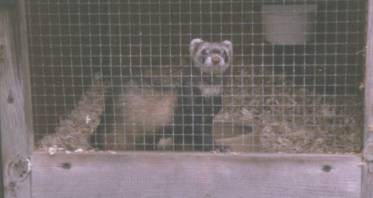Yarm Ferret Rescue - March 2004
by Sue Lloyd
So here we are at the start of another ferret year. Many years ago, it seems like another life, I used to be a volunteer helper on the Keighley and Worth Valley Railway, as the locomotives failed around us I always remember the rallying call of one of our vice chairmen – “There are no such thing as problems, only challenges in life”. Well life is certainly challenging now but just as a steam service was kept going on the K&WVR we just keep going here.
Weather wise, although we’ve had frost, rain, snow and gales in what has seemed like endless winter, it could hardly be described as a hard winter. The ferrets were all slow to pile on the winter layers and all of them rejected their bedding materials of either straw or shredded paper, instead they filled their nest boxes brim full with wood shavings and slept cosily in that.
Polecat jill Theresa was the first ferret for a vet’s bill this year. Over a number of months she started to reject dry food. I checked her teeth which didn’t look too bad, however, in January she seemed to have trouble in eating and had started to
 cough on swallowing possibly due to half chewed food, although meat such as mince had the same effect. Neither the vet nor I thought her teeth too bad but a dental was performed and whilst under anaesthetic her throat was examined. She got the all clear but still she would only pick at a bit of mince. I tried all the ferrets on fresh meat such as pigeon, they had no interest in eating them but they made good toys.
cough on swallowing possibly due to half chewed food, although meat such as mince had the same effect. Neither the vet nor I thought her teeth too bad but a dental was performed and whilst under anaesthetic her throat was examined. She got the all clear but still she would only pick at a bit of mince. I tried all the ferrets on fresh meat such as pigeon, they had no interest in eating them but they made good toys.
Theresa got thinner and thinner but remained very active, the vets can’t feel any tumours and the next step could be to X-ray her. However, following a course of Baytril her appetite has much improved for meat. She eats perfectly well now and can easily chew dry food if she chooses. The vets offered to do an exploratory which I declined, partly due to her being an older ferret and partly due to her habit of removing stitches. Another option is a blood test but as she is happy on mince and diced beef I am leaving her at that for now.
Strauss, a sandy hob, was next at the vets to have a cyst removed from his shoulder region. Although benign it needed removing before it got chance to turn worse, plus as Strauss is a very active vasectomised hob I didn’t want to run the risk of the cyst being bitten into.
All ferrets that have received an anaesthetic, even if only for a short period of time for a minor procedure, away spend that night in the house where they are kept warm. Any ferret with stitches is kept separate until the wound is healed and the stitches removed as playmates can take great delight in chewing out a row of stitches. If we think the ferret may remove its own stitches we usually use subcutaneous ones. I have Theresa to thank for introducing us to these after she removed her stitches following her spay.
Pippa, the hybrid polecat, spends her playtime amusing herself and Hoppy. She never bites and I thought that it might be a good idea to try and mix her in with some younger ferrets, so far I haven’t had any success as she strikes fear into the hobs and fights with most of the jills. I had her in a group of three for a while, no fighting, but no playing either and it was obvious that the three would rather not have Pippa in with them, nor did Pippa care to be with them. After a few weeks Pippa would stand by herself and yapped at the others if they came anywhere near her. I have never heard a ferret be so vocal, nor have I ever heard a ferret bark before. When I first heard her I thought that I’d got a toy breed of dog shut in with the ferrets. I’ve now given up trying to mix Pippa, she doesn’t get on with anyone except Hoppy and me.
Some of our cats are due to be treated with the spot-on form of Frontline; I shall save a few drops to treat some of the ferrets. My own vet approves, one even suggested it as we have such a big problem with ticks. Strauss’ cyst may have formed on the site of a tick bite although up to now I have a 100% record of always removing all of the tick, especially the head. Our cats used to suffer dreadfully with ear mites, Frontline applied to the base of the skull and between the shoulder blades rids the cats of this dreadful irritation and to date I find it a very easy, no mess way of dealing with ear mites, ticks, and fleas in the ferrets.
Quite a few people have contacted me wanting ferrets, mostly polecats, I warm to the words of “we’ll have it neutered” but I’m not sure of people who offer to take a load off my hands; are they being tremendously helpful or are they jumping on the bandwagon and selling to anyone, anywhere.
